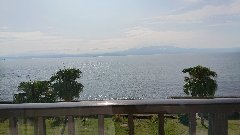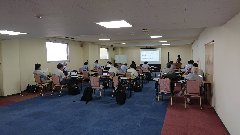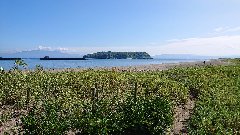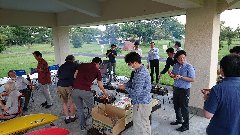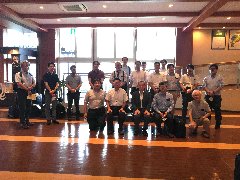The fourth scientific workshop
presented by the 25th URSI-C in Japan
presented by the 25th URSI-C in Japan
Session title:
"Introduction to recent research activities by young researchers"
1. Convener: Dr. Satoshi Yoshida (Kagoshima University)
2. Date/time: 13:20 - 16:30, September 22nd, 2022
3. Venue: Conference Room, Kyukamura Ibusuki (Ibusuki city, Kagoshima pref.)
(Hybrid conference with web conference)
4. Registration fee: Free
5. Listed attendees: 21 persons (local participation), 5 persons (online participation)
6. Local arrangement: Dr. Satoshi Yoshida (Kagoshima University)
7. Session title: "Introduction to recent research activities by young researchers"
8. Presentations:
- 13:20 - 13:30 Opening Remarks
Prof. Noriharu Suematsu, Chair, Commission C of URSI-JNC
(Tohoku University)
- 13:30 - 13:55 "Terminal location estimation method using VHF band radio big data and
machine learning"
Dr. Keiichi Mizutani (Kyoto University) - 13:55 - 14:20 "A PAPR Reduction Method of Multitone Signals by Optimizing Their
Phases with Initial Values Using Algebra and High Autocorrelation Code"
Dr. Hiroto Sakaki (Mitsubishi Electric Corporation)
- 14:20 - 14:45 "Introduction to the Impedance Expansion Method:
Application to Circuit Modeling of Wireless Power Transfer Systems"
Dr. Nozomi Haga (Gunma University) - 14:45 - 14:55 Coffee Break (10 min.)
- 14:55 - 15:20 "Development of Ring Beam for Wireless Power Transfer to Drone"
Dr. Takayuki Matsumuro (Advanced Telecommunications Research
Institute International) - 15:20 - 15:45 "Enhancement of Antenna characteristics using Meta-surface"
Dr. Ryuji Kuse (Kumamoto University) - 15:45 - 16:10 "Mode division multiplex transmission using shielded quad cable"
Dr. Tohlu Matsushima (Kyushu Institute of Technology) - 16:10Closing
Prof. Mitoshi Fujimoto, Vice chair, Commission C of URSI-JNC
(Fukui University)
9.Reception:
It was held from 17:00 to 19:30 at Eco-Camp site, Kyukamura Ibusuki, Ibusuki city, Kagoshima prefecture. The number of attendees was 18.
10.The Steering committee meeting:
It took place from 8:30 to 9:30 on September 23rd, 2022, at Kyukamura Ibusuki.
11. Concluding Remarks
In the past, presentations were given on the state-of-the-art research results in each field such as AP/MW/RCS/ED. This time, however, we asked young researchers who are active in radio-related R&D to give presentations without being restricted to a specific field, and the session was finally organized with presentations by six people. In the circumstances where the number of young researchers is decreasing, we asked all the speakers to be young people, and it was a very valuable opportunity to establish a good connection between well experienced researchers and young researchers. It would be very valuable to continue organizing young researchers' session in the future, even if it is an infrequent event, as it will surely be a very valuable opportunity for them.
Dr. Keiichi Mizutani (Kyoto University) explained the development of a system to estimate base station and terminal locations only by receiving VHF RF signals through machine learning of VHF RF big data. He showed that highly accurate terminal location estimation is possible by applying AI/Big Data, which has become a hot topic in recent years, to radio wave related systems.
Dr. Hiroto Sakaki (Mitsubishi Electric Corporation) proposed the necessity of low PAPR of multi-tone signals to compensate the frequency characteristics of RF front-ends, which have been broadened in recent years, and explained the results of quantitative evaluation by simulating the self-correlation and PAPR of four different codes.
Dr. Nozomi Haga (Gunma University) reported on his research results on circuit modeling methods for wireless power transmission systems using coils. The analytical results of the circuit model derived by the impedance expansion method proposed by Dr. Haga were in good agreement with the results of conventional electromagnetic field analysis, demonstrating the effectiveness of the proposed method.
Dr. Takayuki Matsumuro (Advanced Telecommunications Research Institute International) proposed a null-core beam that has a null at the beam center to solve the problem that the irradiation power to the mission equipment mounted in the center of a drone is maximized with a normal antenna beam when wireless power transmission using microwaves is applied to power supply to a drone, and proposed a new method to reduce the irradiation power to the drone. He reported the simulation results of the method to apply the Laguerre-Gaussian mode.
Dr. Ryuji Kuse (Kumamoto University) proposed the utilization of metasurfaces to improve antenna characteristics, and reported a case study of converting linearly polarized wave to circularly polarized wave and a case study of improving communication capacity in 2x2 LOS MIMO. In both cases, he reported that the edge part of the metasurface did not work as a unit cell. He also reported that the compensation method and its effectiveness were successfully verified.
Dr. Tohlu Matsushima (Kyushu Institute of Technology) proposed that mode-multiplexing transmission, in which signals are assigned to modes of electromagnetic fields, can in principle enable crosstalk-free communication, while conventional differential or single-ended transmission using multi-wire cables cannot ignore crosstalk. He introduced a case study in which a transmitter/receiver system was constructed using a shielded 4-wire cable and the eye pattern was evaluated.
To view larger photo, please click above photo then type password.



